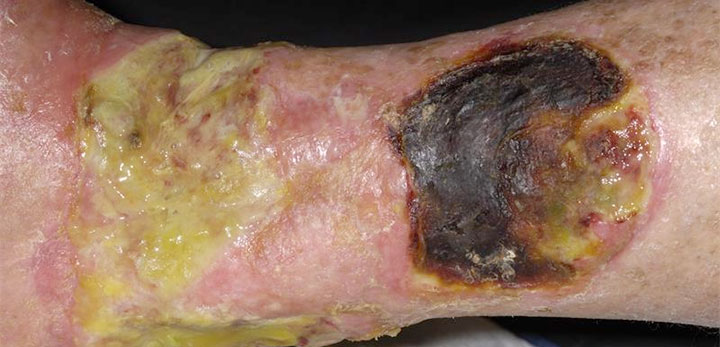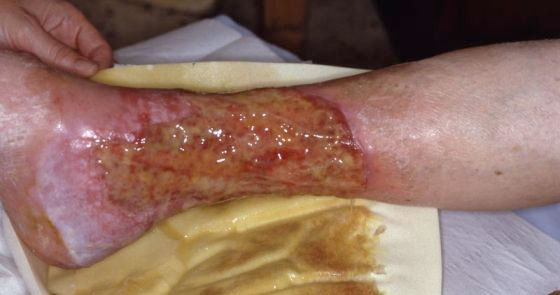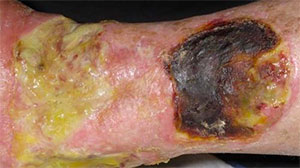By Nancy Morgan, RN, BSN, MBA, WOC, WCC, DWC, OMS
Each issue, Apple Bites brings you a tool you can apply in your daily practice.
Exudate (drainage), a liquid produced by the body in response to tissue damage, is present in wounds as they heal. It consists of fluid that has leaked out of blood vessels and closely resembles blood plasma. Exudate can result also from conditions that cause edema, such as inflammation, immobility, limb dependence, and venous and lymphatic insufficiency.

Accurate assessment of exudate is important throughout the healing process because the color, consistency, odor, and amount change as a result of various physiologic processes and underlying complications.
Consistent terminology is crucial to ensure accurate communication among clinicians. Here are terms you should keep in mind when observing the wound and documenting your findings.
Type
- Serous—thin, clear, watery plasma, seen in partial-thickness wounds and venous ulceration. A moderate to heavy amount may indicate heavy bio-burden or chronicity from a subclinical infection. Serous exudate in the acute inflammatory stage is normal.
- Sanguineous—bloody drainage (fresh bleeding) seen in deep partial-thickness and full-thickness wounds during angiogenesis. A small amount is normal in the acute inflammatory stage.
- Serosanguineous—thin, watery, pale red to pink plasma with red blood cells. Small amounts may be seen in the acute inflammatory or acute proliferative healing phases.
- Purulent—thick, opaque drainage that is tan, yellow, green, or brown. Purulent exudate is never normal and is often associated with infection or high bacteria levels.

Amount
- None—Wound tissues are dry.
- Scant—Wound tissues are moist, but there is no measurable drainage.
- Small/minimal—Wound tissues are very moist or wet; the drainage covers less than 25% of the dressing.
- Moderate—Wound tissues are wet; the drainage involves more than 25% to 75% of the dressing.
- Large or copious—Wound tissues are filled with fluid that involves more than 75% of the dressing.
Consistency
- Low viscosity—thin, runny
- High viscosity—thick or sticky; doesn’t flow easily
Odor
- No odor noted
- Strong, foul, pungent, fecal, musty, or sweet
Use the following terms to describe the condition of primary and secondary wound dressings:
- Dry—The primary dressing is unmarked by exudate; the dressing may adhere to the wound.
- Moist—Small amounts of exudate are visible when the dressing is removed; the primary dressing may be lightly marked.
- Saturated—The primary dressing is wet and strikethrough occurs.
- Leaking—The dressings are saturated, and exudate is leaking from primary and secondary dressings onto the patient’s clothes.
A useful resource to help you with your assessment is the Bates-Jensen Wound Assessment Tool.
Products
Selected references
Bates-Jensen Wound Assessment Tool. http://www
.geronet.med.ucla.edu/centers/borun/modules/
Pressure_ulcer_prevention/puBWAT.pdf. Accessed March 3, 1214.
Romanelli M, Vowden K, Weir D. Exudate management made easy. Wounds International. 2010;1(2). http://www.woundsinternational.com/made-easys/exudate-management-made-easy. Accessed March 3, 2014.
World Union of Wound Healing Societies. Principles of Best Practice: Wound Exudate and the Role of Dressings. London: MEP Ltd; 2007. http://www.woundsinternational.com/clinical-guidelines/wound-
exudate-and-the-role-of-dressings-a-consensus-document/page-1. Accessed March 3, 2014.
Nancy Morgan, cofounder of the Wound Care Education Institute, combines her expertise as a Certified Wound Care Nurse with an extensive background in wound care education and program development as a nurse entrepreneur.
Information in Apple Bites is courtesy of the Wound Care Education Institute (WCEI), copyright 2014.
DISCLAIMER: All clinical recommendations are intended to assist with determining the appropriate wound therapy for the patient. Responsibility for final decisions and actions related to care of specific patients shall remain the obligation of the institution, its staff, and the patients’ attending physicians. Nothing in this information shall be deemed to constitute the providing of medical care or the diagnosis of any medical condition. Individuals should contact their healthcare providers for medical-related information.








wound size is 2.5cm x 2.5cm x 0.2cm
wound base is moist, 50% slough, 50% necrosis
exudate is small amount of greenish sticky purulent.
malodour +++ during the last week
what is the best dressing to apply? thanks
Hi Dora,
I can’t really advise treatment type without more information, Type, location, etc. but what I can advise is the need to rule out infection. Greenish colored, foul odor exudate are definitely signs of infection in the wound bed. Go ahead and culture the wound to see what type of bacteria you have growing, sometimes lime green exudate is significant for Pseudomonas. You then need to select appropriate topical antibacterial treatment to target and get rid of the infection. Select a dressing that will get the infection under control. Wound infection is always the priority. Then you can work on debridement, moist wound healing principles etc.
Good luck!
under odor- it says to use the following to describe the bandage- but then says nothing else?!?!
The plasma leaking from my bashed fingernail is clear with a red tint- sticky, has a pungent odor and a semi moist bandage – nothing above indicated if this is normal or not. is there another part to the article?